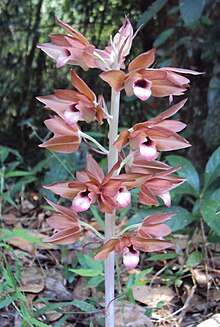| Carrion orchid | |
|---|---|

| |
| Eulophia zollingeri near Kottiyoor, India | |
| Scientific classification | |
| Kingdom: | Plantae |
| Clade: | Tracheophytes |
| Clade: | Angiosperms |
| Clade: | Monocots |
| Order: | Asparagales |
| Family: | Orchidaceae |
| Subfamily: | Epidendroideae |
| Genus: | Eulophia |
| Species: | E. zollingeri
|
| Binomial name | |
| Eulophia zollingeri | |
| Synonyms[1] | |
|
List
| |
Eulophila zollingeri, commonly known as the carrion orchid[2] or 无叶美冠兰 (wu ye mei guan lan),[3] is a plant in the orchid family and is native to areas from tropical and subtropical Asia to Queensland. It is a leafless, brownish terrestrial orchid with up to forty reddish brown, sharply scented flowers with a dark red and yellow labellum. It grows in decaying wood in and near rainforests.
It is classified as a partial mycoheterotroph that maintains a specialized symbiotic relationship with the wood decaying fungi Psathyrellaceae throughout all life stages. Isotopic analysis and chlorophyll data have shown that the orchid also performs its own photosynthesis during the fruiting stage. Its leafless underground habit is typical of saprophytic orchids but it also can perform photosynthesis in its stems.[4]
- ^ a b "Eulophia zollingeri". Plants of the World Online. Retrieved 18 April 2024.
- ^ Jones, David L. (2006). A complete guide to native orchids of Australia including the island territories. Frenchs Forest, N.S.W.: New Holland. p. 359. ISBN 1877069124.
- ^ Cite error: The named reference
Chinawas invoked but never defined (see the help page). - ^ Suetsugu, Kenji; Ohta, Tamihisa; Tayasu, Ichiro (2024). "Partial mycoheterotrophy in the leafless orchid Eulophia zollingeri specialized on wood-decaying fungi". Mycorrhiza. 34 (1–2): 33–44. doi:10.1007/s00572-024-01136-w. ISSN 0940-6360.